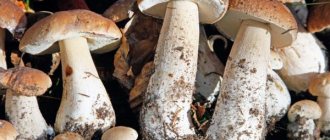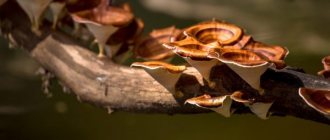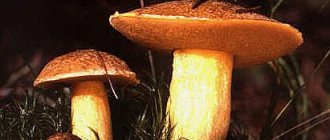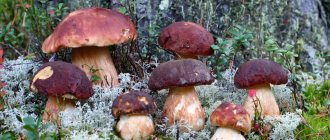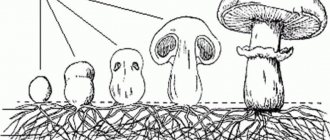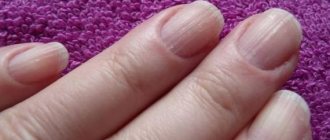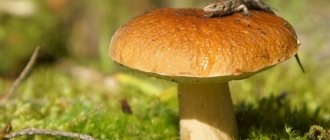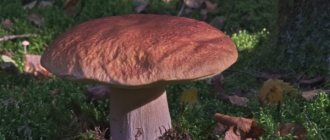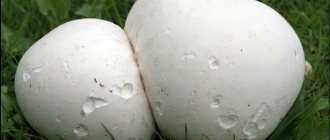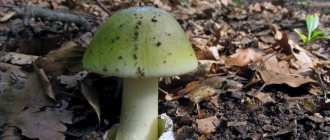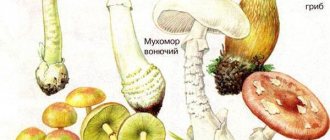Mushrooms
0
1379
Article rating
Kira Stoletova
Cap mushrooms are the highest representatives of the fungal kingdom. Nature has arranged it so that they combine some of the characteristics of animals and plants. Most grow in forests and forest-steppe zones; their mycelium occupies the top layer of soil. For ease of differentiation, people divide them into edible and inedible.
Features of cap mushrooms
Structure
Representatives of the fungal kingdom have a peculiar structure, similar to the structure of plants and animals. They share the following features with flora:
- The cell wall is located above the plasma membrane;
- organisms attached to soil or other surface;
- reproduction occurs by spores;
- presence of vacuoles;
- absorption method of nutrition;
- unlimited growth.
Common features with fauna:
- the composition of cellular structures includes chitin;
- heterotrophic nutrition;
- there is no chlorophyll and chloroplasts in the cells (and other plastids as well);
- metabolic product - urea;
- The main storage nutrient is glycogen.
The structure of the cap mushroom is more complex than that of all representatives of this kingdom. The total size of these multicellular organisms can reach hundreds of meters. Their closest relatives are single-celled bacteria-like yeasts and the ubiquitous molds. This group of mushrooms consists of two parts - the mycelium (vegetative body) and the fruiting body, each part has its own function and characteristics.
Mycelium
What people are accustomed to calling a mushroom is only a temporary reproductive organ. The main part is the mycelium, or mycelium, it grows underground and can live for hundreds of years. It consists of elongated cells with several nuclei. Cells are collected in threads - hyphae. The mycelium looks like a thin cobweb.
There are different types of mycelium:
- The film is a dense interweaving of flat-shaped hyphae that serves to provide nutrition and absorb nutrients from the substrate.
- Cords are fused thread-like hyphae, which are short or long cords that are anchored in the soil and help the mycelium spread to new areas.
- Rhizomorphs are thick filaments, have 2 layers - outer, dense, dark and inner, loose, light.
- Rhizoctonia are thin aerial cords, their significance lies in the spread of the mycelium to new areas.
- Sclerotia are dense clusters of cells that help the fungus survive unfavorable conditions and serve as a storage site for spores.
The mycelium grows in an apical (apical) manner and spreads in a circle. The old part dies off, so the mycelium resembles a ring. Its diameter reaches hundreds of meters. Often the mycelium grows together with the roots of trees and receives nutrients from them, releasing minerals and water. This coexistence is called mycorrhiza.
Fruiting body
The fruiting body of the cap mushroom also consists of thin hyphae in the form of intertwined strands, collected into a dense mass. They are clearly visible on the cut. The body is divided into a stalk and a cap. The leg is thick and long, in some species it has thickenings and rings. It lifts the cap with spores above the ground, preventing its premature rotting. Truffles, morels and some other species do not have a typical stem. The stem is attached to the center of the cap, eccentrically (slightly to the side of the center) or sideways (towards the edge).
The upper part of the cap is pigmented. The lower part is the hymenophore, in which spores mature. It comes in different types. The structure of cap mushrooms is distinguished precisely by it:
- tubular;
- lamellar;
- folded;
- labyrinthine;
- spiny.
The hymenophore of tubular mushrooms has a sponge-like structure and consists of thin round cavities with spores. The lower part of the cap of lamellar and folded mushrooms can be said to be corrugated. The plates, similar to a fan, diverge from the stem to the edge of the cap. The labyrinthine hymenophore is a complex system of tubes. The hymenophore cap mushroom rarely has a spiny structure, although such forms also occur.
The lower part of the cap comes in different types
The fruiting body grows from the mycelium in warm and humid weather. Its main function is to form and spread spores. The bodies develop quickly, their growth increases, but they live only 1-2 weeks. Often they are eaten by animals, sometimes they end up in a person's basket. When this part of the fungus dies, it becomes a breeding ground for the mycelium.
general characteristics
Ambient humidity and temperature are of great importance for the growth of cap mushrooms. The optimal humidity level is 50-80%. In this case, not only the soil, but also the air must be moist.
Depending on the species, a certain type of lighting is required. Some require open space (meadows, forest edges), others require sparse forests, and some do not require lighting at all.
Soils for growth can be different: chernozem, gray and brown forest, clayey and loamy, sandy loam and sandy, calcareous.
Nutrition of cap mushrooms
The body of the cap mushroom does not have the ability to independently synthesize the organic substances necessary for its life. It receives all useful compounds from the substrate on which it grows. This type of nutrition is called heterotrophic; it is characteristic of fungi and animals. In some ways, lichens are heterotrophs. These organisms are the result of a symbiosis of fungi and algae.
Nutrients are supplied through the mycelium. Cells are able to absorb only dissolved and broken down substances into simple compounds. Therefore, the mycelium releases enzymes into the external environment that “digest” complex carbohydrates, proteins and fats, turning them into complexes accessible for absorption. Even the caps secrete such enzymes. This means that the fungus has external digestion, which provides the body with amino acids, glucose, simple lipids and other compounds.
According to the method of feeding, the following types are distinguished:
- saprophytes;
- symbiotics (symbionts);
- parasites.
Saprophytes live in soil rich in organic matter. They receive from it everything they need for life, development and growth. These organisms are capable of processing tons of cellulose and starch. They are an important part of the forest biocenosis and play a large role in the processing of organic matter and soil formation.
Symbiosis (mycorrhiza) with fungi is formed by oak, birch, pine, beech and many other tree species. The mycelium penetrates the root cells and supplies them with water and minerals, taking part of the nutrients (organic) substances for itself. As a result, the tree’s absorption area increases, and the fungus has the ability to absorb organic matter.
Parasites represent a special group; they penetrate under the bark of trees, suck nutrients from the cells of a living plant and destroy the wood. The plant dies, but the mushrooms continue to feed on it. Some species can parasitize one plant for decades, because... the mycelium grows slowly. Other destroyers manage to kill a tree in 1-2 seasons.
Reproduction
Most higher species are basidiomycetes. Their spores mature in club-shaped formations - basidia. Reproduction of all cap mushrooms occurs in two ways - asexual and sexual.
Asexual reproduction
Asexual reproduction occurs through conidia, but is rare. The diagram looks like this:
- two vegetative cells with one nucleus and a full set of chromosomes merge;
- first, the cytoplasm joins, then the nuclei come together (but not merge) to form the so-called dikaryon (2 nuclei are retained);
- fission of two nuclei occurs simultaneously;
- the mycelium continues to grow, while its structure contains dozens of dikaryons.
The process of asexual reproduction can last months and even years. It is accompanied by the formation of small lateral processes - buckles. They are responsible for the simultaneous division of nuclei.
Sexual reproduction
Fungi reproduce by spores
The cap mushroom most often reproduces sexually, which is carried out using basidiospores and consists of the following stages:
- the nuclei of the dikaryon merge, a zygote is formed, which is divided by meiosis (only half of the chromosomes remain in the daughter cells);
- after division, 4 cells are formed, which are called basidiospores, the mother cell is called basidium;
- in many varieties, basidiospores are located on tiny projections - sterigmata;
- The basidia are located on the lower part of the cap of the fruiting body - the hymenophore, where spore fusion occurs.
Irina Selyutina (Biologist):
Once spores have formed, they must be released from the spore-forming organs. Released spores can partially settle in the immediate vicinity of the fungus or spread over various distances.
The following methods of spreading cap mushroom spores are distinguished:
- Anemochory: with the help of air. This is the most common option.
- Zoochoria: with the help of animals (ants, squirrels, birds).
- Entomochory: transfer is carried out by insects (ants).
- Anthropochory: human-assisted spread.
- Hydrochoria: with streams of water.
Disputes are divided into:
- Propagative: developing in huge numbers and serving for the rapid dispersal of fungi, but at the same time short-lived and often immature. Thus, up to 7.5 million spores are formed in the fruiting body of the puffball, and champignons form over 10 billion spores in 5 days.
- Dormant: they develop little, they need a certain time for ripening (dormant period) and serve to preserve the species under unfavorable conditions. They can retain the ability to germinate for 10-12 years.
Mature spores spill out from the bottom of the cap and are carried by wind or water currents. Often mushroom bodies are eaten by animals. The spores are not digested in the gastrointestinal tract and are released into the external environment unchanged. Mushrooms spread tens or hundreds of kilometers from their original place of growth.
If the caps are collected by humans, they also have a chance of spreading spores. Old or wormy mushrooms are thrown away; their spores often germinate in a new place. This does not apply to all varieties. Some are capricious to their habitat and grow only near certain trees (boletus, boletus, boletus). Other cap mushrooms take root on any substrate, for example, champignons, russula.
Features of life
New myceliums appear in places with a large layer of humus, as well as next to the corresponding trees.
Different types of mushrooms are “friends” with certain types of trees
, near which they are grouped.
The appearance of fruiting bodies in different species does not occur simultaneously. Dry weather is not favorable.
The most conducive to the appearance of fruiting bodies is a uniform change of heat and coolness, bringing light rains. Early cold snaps also stop growth.
Types of cap mushrooms
The scientific classification is complex, although it reflects all the diversity of the mushroom kingdom. From a practical point of view, it is more convenient to divide all types of mushrooms into the following groups or categories:
- edible;
- conditionally edible;
- inedible;
- poisonous.
Edible mushrooms
Edible cap mushrooms grow in forests, sometimes they are bred artificially. Most of them are tubular, but some are plate-like. They have high nutritional value and pleasant taste, some have a strong aroma. Cooking does not take much time; after boiling, they are eaten within 20-30 minutes. The most popular types:
- White mushroom;
- boletus;
- boletus;
- boletus;
- russula;
- champignon;
- flywheel
These species form symbiosis with different trees. Mycorrhiza helps obtain organic matter from higher plants. Many edible varieties grow as saprophytes and take everything they need from the soil.
Conditionally edible mushrooms
Conventionally, edible mushrooms must be soaked
Conditionally edible species often have a lamellar or folded hymenophore, and even have a spiny hymenophore. They are eaten after additional processing (boiling in several waters, soaking, salting). In terms of taste, representatives of this category are inferior to edible ones; they have their own characteristic features - hard structure, bitterness, weak aroma.
Conditionally edible ones include:
- waves;
- rows;
- morels;
- milk mushrooms;
- lacticians;
- ramaria;
- bitters;
- oak trees;
- hedgehogs.
They are characterized by a saprophytic or parasitic way of life; they form symbiosis with trees less frequently than their edible counterparts.
Inedible mushrooms
This category includes non-poisonous types that should not be eaten due to poor taste, bitterness, and hardness. These properties do not disappear even after cooking, this is their difference from conditionally edible ones. Examples of inedible mushrooms:
- satanic mushroom;
- pepper mushroom;
- tinder;
- orange aleuria;
- serushka;
- Russula Meira;
- some types of milk mushrooms.
The structure of the fruiting bodies of such cap mushrooms is different. More often they are lamellar, although the Satanic mushroom has a tube-shaped hymenophore. Their diet is heterotrophic; they include both saprophytes and parasites.
Poisonous mushrooms
Poisonous cap mushrooms are the most dangerous group that takes dozens of lives every year, as the facts inexorably show. They contain substances that cause poisoning in humans. They act on the liver, blood, and nervous system. Most poisonous species are lamellar, many have bright colors, thickenings and corollas.
Common poisonous cap mushrooms are the following:
- death cap;
- fly agaric;
- false scent;
- false chanterelle;
- row is poisonous.
There are poisonous species - doubles of edible ones. For example, toadstool can easily be confused with russula or champignon. False honey mushrooms are similar to real ones (summer and winter). Although there are not only similarities between them, but also significant differences. Therefore, picking mushrooms in the forest is advised only to those who are well versed in them. A detailed description and characteristics, a table with pictures, helps to recognize poisonous mushrooms.
In addition to poisonous cap mushrooms, there are interesting and unusual varieties that act on the nervous system and cause hallucinations. In normal doses they do not cause fatal poisoning and do not provoke drug addiction. But with regular use, people sometimes experience mental disorders, so comprehensive treatment is required. In most countries, hallucinogenic varieties are prohibited from growing and distributing.

